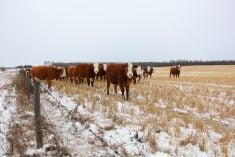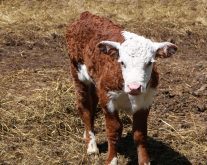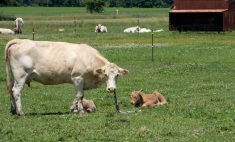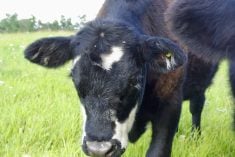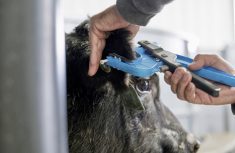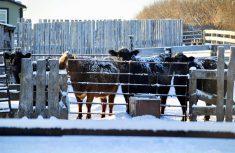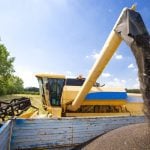Winter can be a tough time for young cows in a so-called normal year, but with drought leaving many producers short on pasture this year, cattle may be going into winter thinner than usual. That means heifers and young cows may need special care this year, says a research scientist.
“One of the most important things a producer can do is feed the heifers and first-calf heifers separate from the main cow herd and try to meet their nutritional needs. They have higher requirements for energy and protein than a mature cow, so we need to adjust their diet accordingly,” says Dr. Tim McAllister, based at Agriculture and Agri-Food Canada’s Lethbridge Research and Development Centre.
Read Also

Canadian Beef Check-Off Agency reports on investments and activities
The check-off agency’s work behind the scenes is what ensures cattle check-off dollars are invested wisely, accounted for transparently and deliver measurable value back to producers and importers.
“Many ranchers winter the whole herd together and this puts heifers at a disadvantage. Cows are also more dominant and tend to push heifers away from the feed, so the heifers end up getting potentially even lower-quality feed than the cows because the cows are getting first choice.”
Heifers should be fed to meet their energy requirements, without exceeding them. Overfeeding heifers can lower milk yield and lead to issues such as dystocia and death loss during calving. However, while overfeeding heifers can be a problem in a regular year, McAllister doesn’t think it’s likely to be a problem this year.
Given the variability in feed quality this year, feed testing will be important, says McAllister. Consider supplementing if forages are low in energy or protein, he adds.
“If your forages have a variety of levels of quality, select the higher quality for the heifers and feed the lower-quality forages to cows.”
This year many producers are looking at alternative forages if they are short on hay. “A person might use supplemental feeds like grain screenings or screenings from the lentil industry. These are high-quality feeds that could be fed to heifers, but you need to be set up to feed these.”
Feeding screenings from the ground creates too much waste. Feed bunks or troughs are a better option. Something as simple as a few plastic barrels bolted together, or a few old tires laid out can work, too.
Also, pay attention to trace mineral and vitamin requirements. “Look at the diet as a whole. Calcium requirements, for instance, will be higher for heifers than for cows.”
With the drought, it also pays to know nitrate levels in certain forages and feeds. Test before purchasing. “I’ve had calls this fall from people who are worried about the potential for nitrate poisoning, looking at oats or greenfeed they purchased. Some of the forages and cereal crops that were baled early may also have high nitrate levels, so you need to test,” McAllister says.
McAllister doesn’t recommend using high-nitrate feeds with heifers. But if nitrate levels aren’t too high, producers might be able to transition older cows to that feed gradually by diluting it with other low-nitrate feeds.
“You might get high-nitrate feeds at a discount because of the risk associated with them and if you can manage them properly, the energy in that feed is still present and you might be able to make it work. You’d need to monitor the animals carefully and watch for any signs of nitrate toxicity and back off if you see problems. You don’t want to abort any cows.”
Windbreaks also help heifers get through a tough winter. “If they have decent feed, a windbreak and access to water, they can do well, even in severe weather.”
This can be another reason to have them in their own group; if there is limited space behind a windbreak the cows may take the best spots and shove the heifers away. Bedding can also be a good idea in some situations.
“I’ve always been amazed at how well cattle handle cold temperatures if they have a decent windbreak and bedding — not having to lie in snow or on frozen ground.”
Advice from a breeder
Travis Olson runs 1,500 cows on his Angus operation, Ole Farms, at Athabasca, Alta. He says the main consideration when wintering heifers is nutrition.
“Years ago, my nutritionist told me there are two things a cow needs to do. She needs to maintain herself and grow a fetus. Then when she calves, she needs to maintain herself and feed that calf. A cow has those two things to do, but a heifer has three; she has to maintain herself, feed her calf and grow,” says Olson.
A healthy heifer with adequate body condition and a good hair coat can withstand a lot of cold weather. “Here in Western Canada, we get a lot of dry, powdery snow and cattle can stay warm enough if they have adequate back fat and good hair. They are not wet and can stay dry. If they don’t have enough fat for insulation, however, bad weather can be really hard on them.”
Heifers also need enough condition and strength at calving time to carry them through a difficult labour, especially as they take more time at labour than older cows, he adds.
The Olsons record rate of gain on their cattle, weighing them at multiple points throughout their lives. They also keep detailed calving records, including whether calves are dead at birth. Olson says in years when cows simply hold their weight through the winter, they don’t do as well as when they gain weight through pregnancy. For example, one year they wintered the cows on a corn crop and the cows gained about two-thirds of a pound per day. They saw a significant improvement in mortality rates of calves at birth that year.
“The mortality rate that year was 1.6 per cent rather than the typical 2.9 per cent mortality at birth.”
Olson says heifers should weigh enough to carry some extra flesh. How much depends on what the heifers weigh when they’re bred, but it’s a considerable amount of weight.
“If her full-term calf weighs about 70 pounds, plus another 50-plus pounds of fluid surrounding that calf in the uterus, that’s 120 pounds. If she weighs 1,000 pounds, that’s 12 per cent of her body weight. So a heifer needs to gain 120 pounds between the time you bred her and the time she calves, above and beyond her own growth.”
A pound lost in October will cost a lot more to put back on later. Olson says if feed is limited, a producer might be able to make the cows work harder, but should make sure heifers have enough feed to gain weight. He suggests wintering heifers separately from the cows.
“Some producers winter bred heifers with their first-calf heifers, along with some of their older thin cows and feed them separate from the main herd. The old saying, ‘man must measure’ is true; you need to know what your cattle are doing and weigh them if you can. Weigh them at the start and weigh them again halfway through winter, to see how they are doing, especially if you have to make them work a little harder because hay is expensive.”
A good mineral program is also important, along with adequate protein and energy. “Most of the feed produced this year will be short on certain nutrients. If you are trying to balance rations with straw, make sure you have adequate calories as well as protein. Many rations will have more protein than needed since those heifers are not lactating. They don’t have a high protein requirement. If they are short on energy, however, and have to convert protein into energy, they do it very inefficiently.”
In a year when feed is short, a person has to figure out what is available, what it costs and how best to balance the ration. “I was recently looking at the fact that a person can ship corn in from the U.S. for about 17.25 cents per pound, whereas second-cut hay is going for about 10 to 11 cents per pound — yet a person is better off to buy the more expensive corn in terms of caloric value,” says Olson.
This might be different if cattle are on winter pasture that is short on protein. This year, however, most people who would have had some banked grass for winter have already grazed it. Most of the forages, which tend to be limited in protein during winter, are already gone.
“In our area, there is a lot of straw baled and a lot of red clover. Some guys grow red clover seed and bale the residue. That’s what we’ve been baling. Most people are doing different things this year, to have enough forage for cattle, so it’s important to consult with a nutritionist to make sure the diet is balanced and will work. I’ve been in this business a long time and have a good understanding about cattle nutrition, but I still have a nutritionist help me balance a ration,” he says.
Many operations might be making their heifers work a little too hard, Olson says.
“You can make them work hard the rest of their life, but not during year one. With a bred heifer, a good per cent of her body weight is the calf she is carrying and that next year she has to rebreed after giving birth to that calf, so she needs extra help until she gets past that point. If a person is running heifers with the cows, the cows are usually in good shape but the heifers often get a little thin. You need to find a way to sort out those heifers and make their lives a little easier.”



